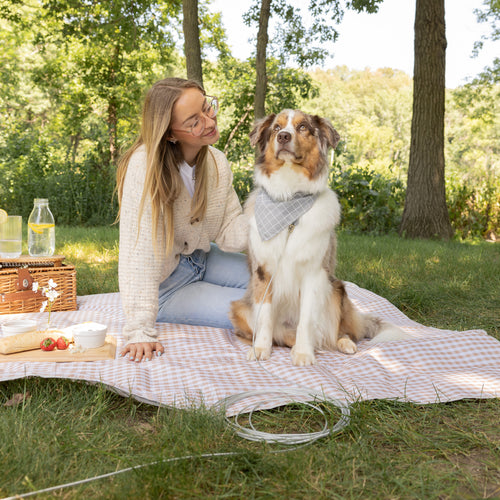#1 Pet Gates in the USA
Carlson Pet Products: The #1 Pet Gates in the USA
December 19, 2025

Active Dog
July 29, 2024
Hey there, dog owners! If you're like many of us, your furry friend is an integral part of your life. You probably want to make sure they have plenty of freedom to roam and play, but safety always comes first. That’s where Carlson Dog Tie-Outs into play. They’re a handy tool for giving your pup a bit of outdoor freedom without the need for a full fence or constant supervision. However, just like any tool, there are important safety considerations to keep in mind. Let’s dive into some essential tips to ensure your dog tie-out experience is safe and enjoyable for both you and your pup.

The first step in ensuring safety with a dog tie-out is to select one that’s appropriate for your dog’s size and weight. Tie-outs come in various lengths, so it’s crucial to pick one that suits your dog’s needs. For larger or more powerful breeds, the Carlson Large Dog Tie-Out Cable is necessary to withstand their pulling force. Smaller dogs can usually get by with the Carlson Small Dog Tie-Out. Always check the manufacturer’s recommendations and reviews to ensure you’re choosing a product that will hold up under your dog’s specific demands.
Once you’ve chosen the right tie-out, proper installation is key. Ensure that the tie-out is securely anchored to a solid, stable object, such as the Carlson Domed Barbed Stake or Carlson Triangle Screw Stake. It should be firmly in place to prevent your dog from pulling it loose. Make sure the anchor point is at a safe height and distance from any obstacles or hazards. If the tie-out is anchored to a post, ensure it’s firmly set into the ground and won’t come loose if your dog pulls on it.
Dog tie-outs can wear out over time, especially with regular use. Regularly inspect the tie-out for any signs of wear and tear, such as rusting or damage to the swivel or anchor. Replace any worn-out or damaged components immediately to avoid potential accidents. A little maintenance goes a long way in ensuring your dog’s safety.
One of the most common mistakes with dog tie-outs is not providing enough space for your dog to move around comfortably. Ensure that the tie-out is long enough to give your dog sufficient room to run, play, and explore, while still being within a safe range. Be mindful of the space around the tie-out; make sure there are no sharp objects, hazards, or potential entanglement points in your dog’s range.
Even with the safest setup, supervision is crucial. Never leave your dog unattended for extended periods while they’re on a tie-out. Accidents can happen, and it’s important to be nearby to monitor your dog’s safety. This also allows you to intervene quickly if your dog starts to exhibit signs of distress or if the tie-out becomes tangled.
Weather conditions can greatly affect your dog’s comfort and safety. During extreme heat or cold, it’s best to avoid using the tie-out. Dogs can overheat quickly in hot weather, and extreme cold can lead to hypothermia or frostbite. If you need to keep your dog outside during adverse weather conditions, make sure they have access to shelter and are not left tied out for long periods.
Training your dog to understand the tie-out is essential. Start with short periods of supervised time and gradually increase the duration as your dog gets accustomed to it. Teach your dog to stay within the boundaries of the tie-out and to avoid tangling. Positive reinforcement, like treats and praise, can help your dog associate the tie-out with positive experiences.
While tie-outs can be a great tool, they aren’t always the best option for every dog. If your dog has a tendency to escape or chew through the tie-out cable, or if they become anxious when tied up, it might be worth considering alternatives. For example, a fenced-in yard or a pet pen can provide more security and freedom without the risks associated with tie-outs. Evaluate your dog’s behavior and needs to determine the best setup.
If you have other animals around, such as other pets or wildlife, be aware of how they might interact with your dog on a tie-out. Encounters with other animals can sometimes lead to aggressive behavior or anxiety. Make sure the area around the tie-out is secure and free from potential threats or distractions that might upset your dog.
Lastly, stay informed about any new safety guidelines or improvements in dog tie-out products. Technology and safety standards are always evolving, and keeping up-to-date can help you make the best choices for your dog’s safety and well-being. Adapt your approach as needed based on your dog’s changing needs and circumstances.

By following these safety tips, you can help ensure that your dog’s time on a tie-out is safe and enjoyable. Remember, your dog relies on you to provide a secure environment where they can enjoy their outdoor time. With the right precautions and a little bit of attention, you can make sure your pup has a great time while staying safe. Happy tying out, and here’s to many fun and safe adventures with your furry friend!